Learning and Development Strategy at Red Communications: A Case Study
VerifiedAdded on 2020/04/07
|10
|1894
|30
Case Study
AI Summary
This case study analyzes Red Communications, an Australian organization, focusing on its Learning and Development (L&D) strategy. The report examines the company's background, including its restructure and expansion, highlighting the importance of training in cultural and technical fields. The analysis emphasizes the role of L&D in enhancing employee performance, efficiency, and profitability. It reviews the literature on adult learning (Andragogy), emphasizing self-concept, readiness, and experience in the context of training effectiveness. The study identifies core competencies within Red Communications, such as retail marketing strategy and addresses issues like growth and revenue. Furthermore, it highlights a literature gap regarding the comprehensive analysis of training needs and objectives, proposing the use of surveys and performance management for effective L&D interventions. The conclusion underscores the significance of training in contributing to Red Communications' long-term success.
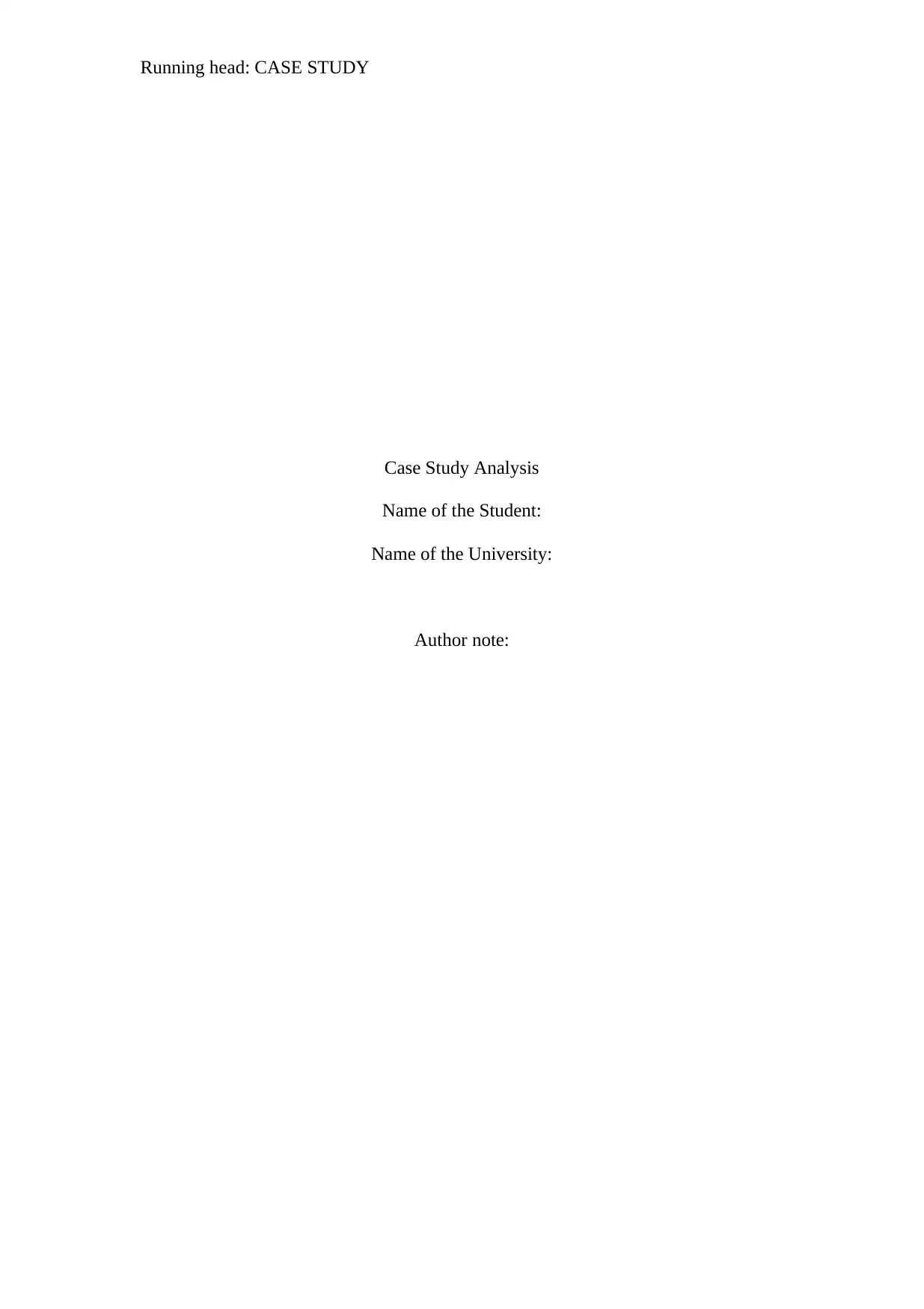
Running head: CASE STUDY
Case Study Analysis
Name of the Student:
Name of the University:
Author note:
Case Study Analysis
Name of the Student:
Name of the University:
Author note:
Paraphrase This Document
Need a fresh take? Get an instant paraphrase of this document with our AI Paraphraser
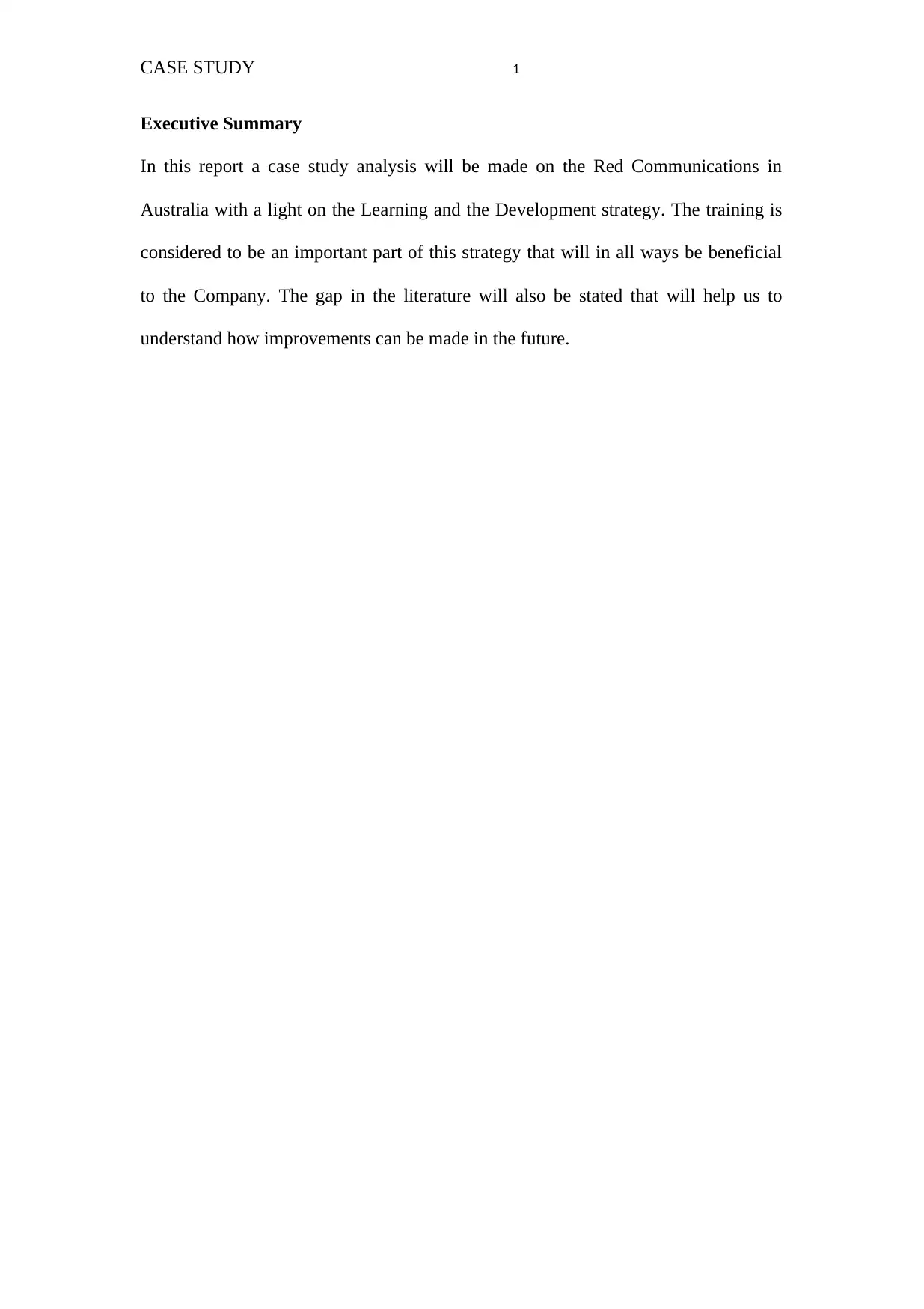
CASE STUDY 1
Executive Summary
In this report a case study analysis will be made on the Red Communications in
Australia with a light on the Learning and the Development strategy. The training is
considered to be an important part of this strategy that will in all ways be beneficial
to the Company. The gap in the literature will also be stated that will help us to
understand how improvements can be made in the future.
Executive Summary
In this report a case study analysis will be made on the Red Communications in
Australia with a light on the Learning and the Development strategy. The training is
considered to be an important part of this strategy that will in all ways be beneficial
to the Company. The gap in the literature will also be stated that will help us to
understand how improvements can be made in the future.
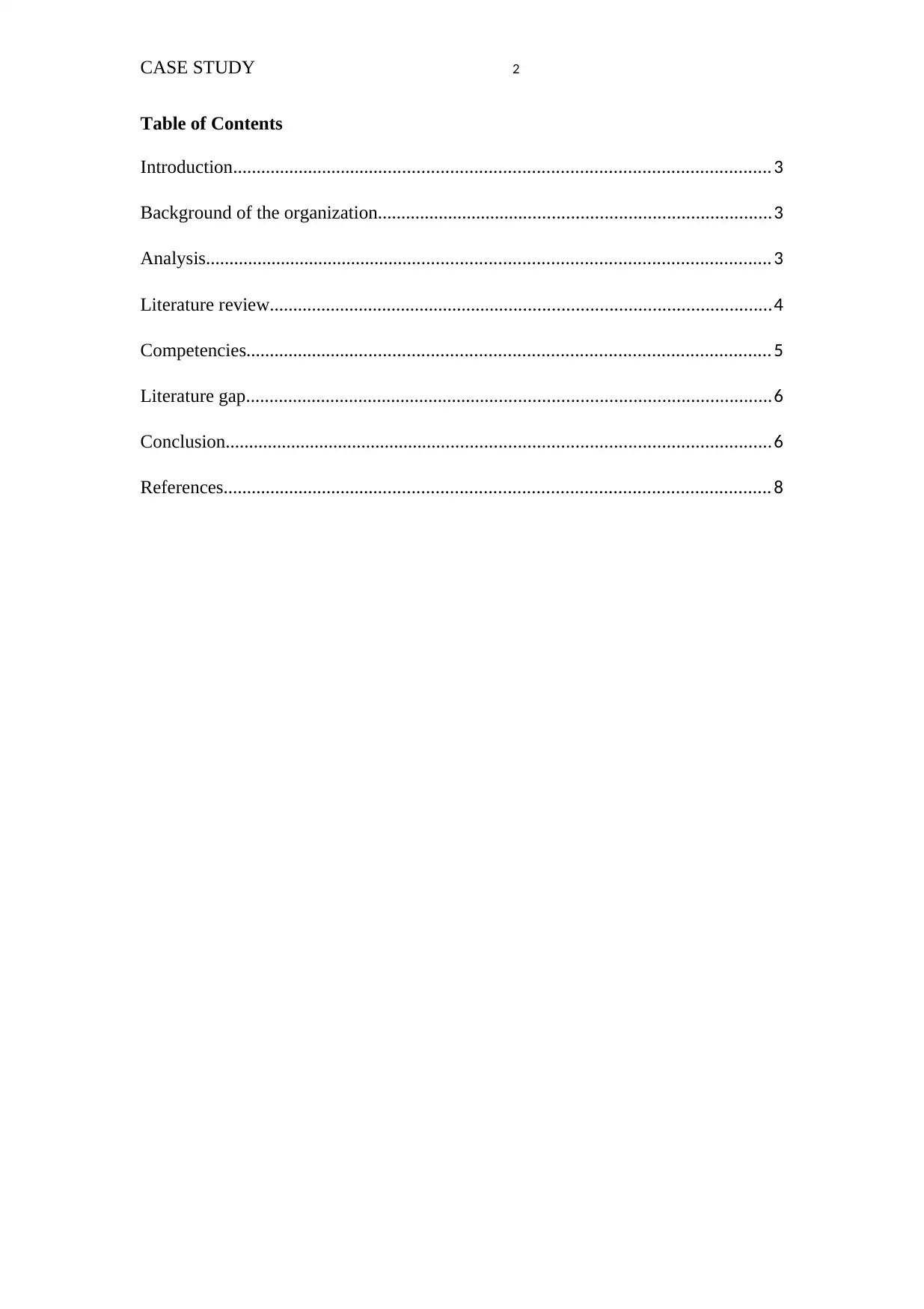
CASE STUDY 2
Table of Contents
Introduction................................................................................................................. 3
Background of the organization...................................................................................3
Analysis....................................................................................................................... 3
Literature review..........................................................................................................4
Competencies.............................................................................................................. 5
Literature gap...............................................................................................................6
Conclusion...................................................................................................................6
References................................................................................................................... 8
Table of Contents
Introduction................................................................................................................. 3
Background of the organization...................................................................................3
Analysis....................................................................................................................... 3
Literature review..........................................................................................................4
Competencies.............................................................................................................. 5
Literature gap...............................................................................................................6
Conclusion...................................................................................................................6
References................................................................................................................... 8
⊘ This is a preview!⊘
Do you want full access?
Subscribe today to unlock all pages.

Trusted by 1+ million students worldwide
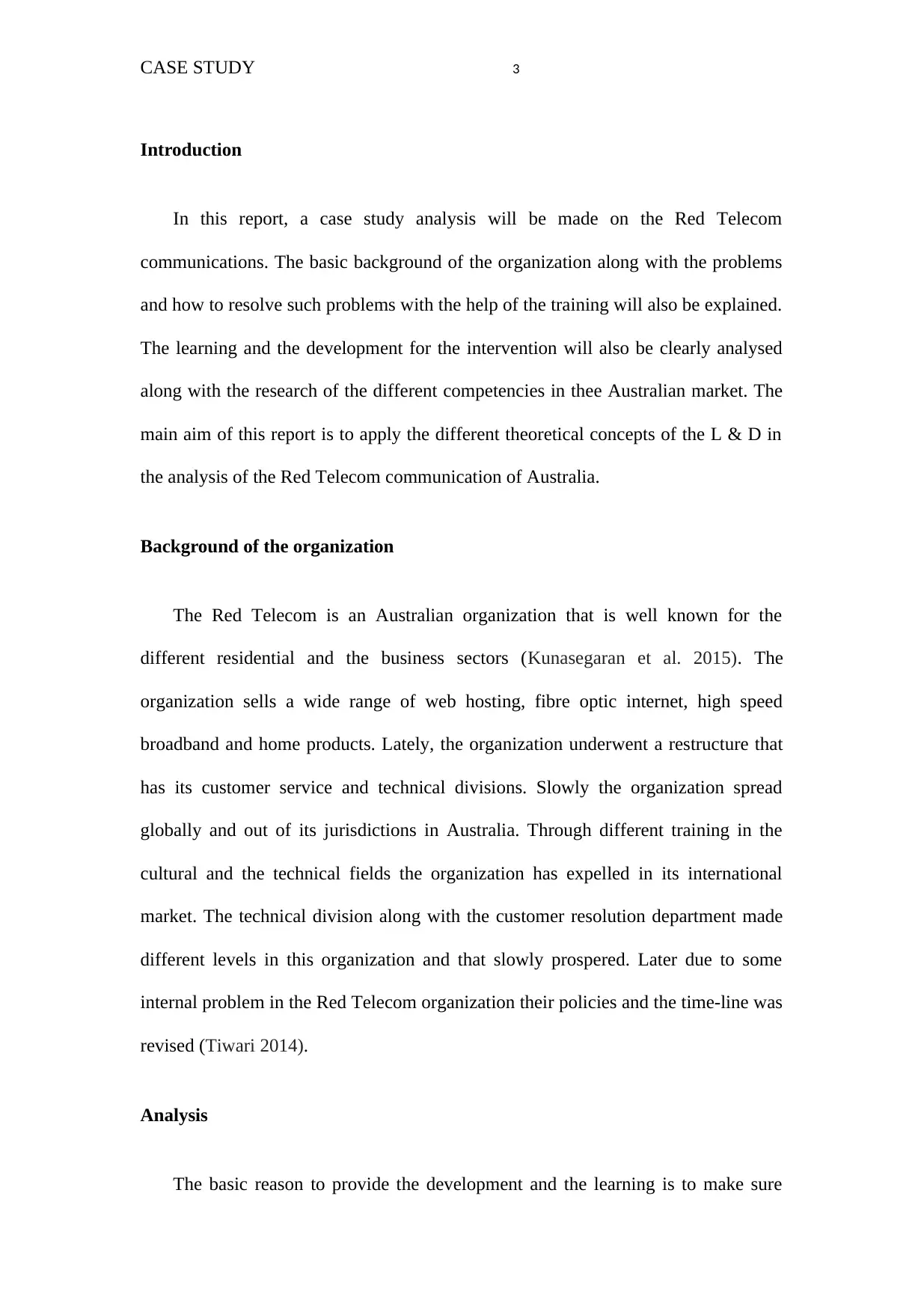
CASE STUDY 3
Introduction
In this report, a case study analysis will be made on the Red Telecom
communications. The basic background of the organization along with the problems
and how to resolve such problems with the help of the training will also be explained.
The learning and the development for the intervention will also be clearly analysed
along with the research of the different competencies in thee Australian market. The
main aim of this report is to apply the different theoretical concepts of the L & D in
the analysis of the Red Telecom communication of Australia.
Background of the organization
The Red Telecom is an Australian organization that is well known for the
different residential and the business sectors (Kunasegaran et al. 2015). The
organization sells a wide range of web hosting, fibre optic internet, high speed
broadband and home products. Lately, the organization underwent a restructure that
has its customer service and technical divisions. Slowly the organization spread
globally and out of its jurisdictions in Australia. Through different training in the
cultural and the technical fields the organization has expelled in its international
market. The technical division along with the customer resolution department made
different levels in this organization and that slowly prospered. Later due to some
internal problem in the Red Telecom organization their policies and the time-line was
revised (Tiwari 2014).
Analysis
The basic reason to provide the development and the learning is to make sure
Introduction
In this report, a case study analysis will be made on the Red Telecom
communications. The basic background of the organization along with the problems
and how to resolve such problems with the help of the training will also be explained.
The learning and the development for the intervention will also be clearly analysed
along with the research of the different competencies in thee Australian market. The
main aim of this report is to apply the different theoretical concepts of the L & D in
the analysis of the Red Telecom communication of Australia.
Background of the organization
The Red Telecom is an Australian organization that is well known for the
different residential and the business sectors (Kunasegaran et al. 2015). The
organization sells a wide range of web hosting, fibre optic internet, high speed
broadband and home products. Lately, the organization underwent a restructure that
has its customer service and technical divisions. Slowly the organization spread
globally and out of its jurisdictions in Australia. Through different training in the
cultural and the technical fields the organization has expelled in its international
market. The technical division along with the customer resolution department made
different levels in this organization and that slowly prospered. Later due to some
internal problem in the Red Telecom organization their policies and the time-line was
revised (Tiwari 2014).
Analysis
The basic reason to provide the development and the learning is to make sure
Paraphrase This Document
Need a fresh take? Get an instant paraphrase of this document with our AI Paraphraser
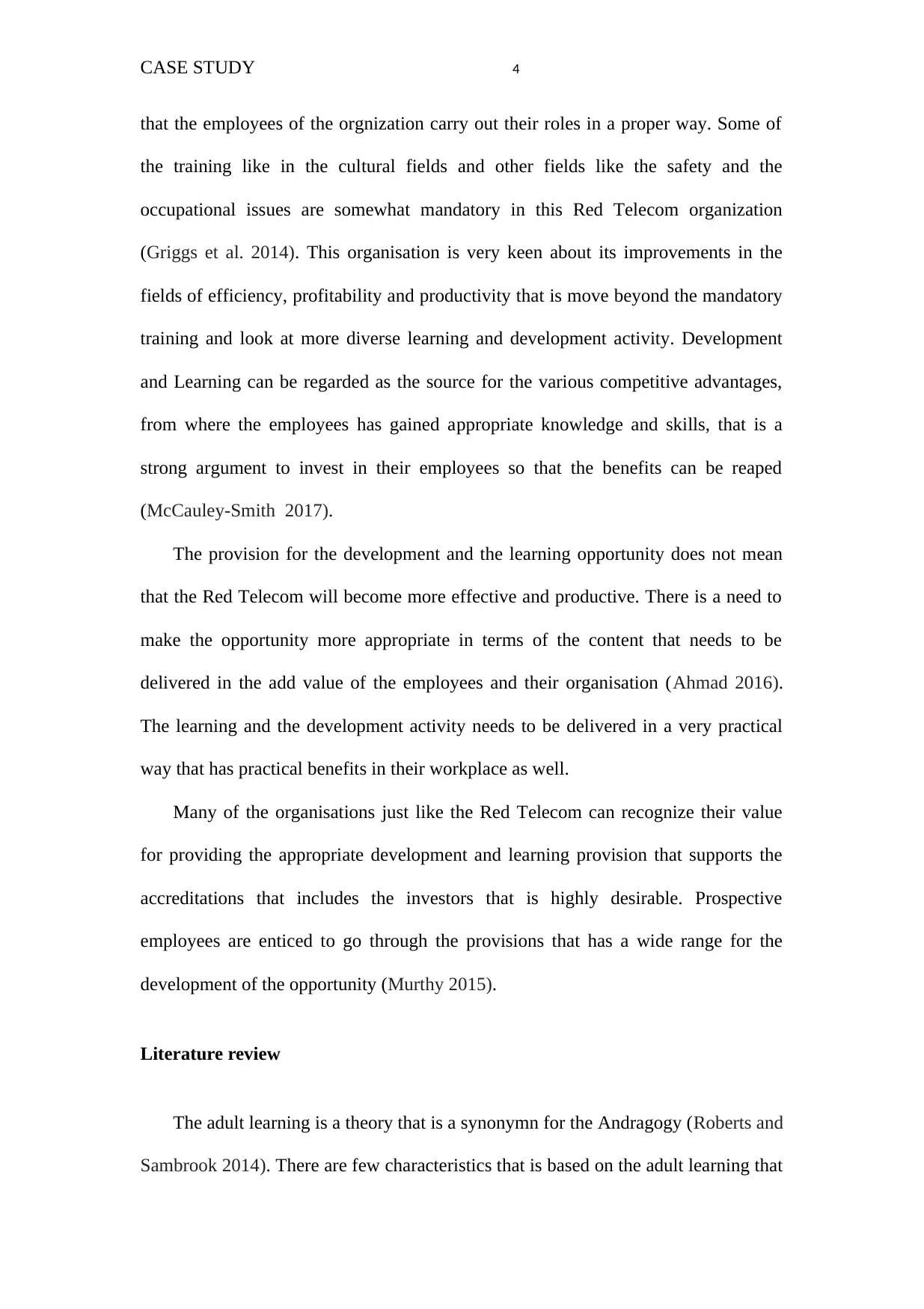
CASE STUDY 4
that the employees of the orgnization carry out their roles in a proper way. Some of
the training like in the cultural fields and other fields like the safety and the
occupational issues are somewhat mandatory in this Red Telecom organization
(Griggs et al. 2014). This organisation is very keen about its improvements in the
fields of efficiency, profitability and productivity that is move beyond the mandatory
training and look at more diverse learning and development activity. Development
and Learning can be regarded as the source for the various competitive advantages,
from where the employees has gained appropriate knowledge and skills, that is a
strong argument to invest in their employees so that the benefits can be reaped
(McCauley-Smith 2017).
The provision for the development and the learning opportunity does not mean
that the Red Telecom will become more effective and productive. There is a need to
make the opportunity more appropriate in terms of the content that needs to be
delivered in the add value of the employees and their organisation (Ahmad 2016).
The learning and the development activity needs to be delivered in a very practical
way that has practical benefits in their workplace as well.
Many of the organisations just like the Red Telecom can recognize their value
for providing the appropriate development and learning provision that supports the
accreditations that includes the investors that is highly desirable. Prospective
employees are enticed to go through the provisions that has a wide range for the
development of the opportunity (Murthy 2015).
Literature review
The adult learning is a theory that is a synonymn for the Andragogy (Roberts and
Sambrook 2014). There are few characteristics that is based on the adult learning that
that the employees of the orgnization carry out their roles in a proper way. Some of
the training like in the cultural fields and other fields like the safety and the
occupational issues are somewhat mandatory in this Red Telecom organization
(Griggs et al. 2014). This organisation is very keen about its improvements in the
fields of efficiency, profitability and productivity that is move beyond the mandatory
training and look at more diverse learning and development activity. Development
and Learning can be regarded as the source for the various competitive advantages,
from where the employees has gained appropriate knowledge and skills, that is a
strong argument to invest in their employees so that the benefits can be reaped
(McCauley-Smith 2017).
The provision for the development and the learning opportunity does not mean
that the Red Telecom will become more effective and productive. There is a need to
make the opportunity more appropriate in terms of the content that needs to be
delivered in the add value of the employees and their organisation (Ahmad 2016).
The learning and the development activity needs to be delivered in a very practical
way that has practical benefits in their workplace as well.
Many of the organisations just like the Red Telecom can recognize their value
for providing the appropriate development and learning provision that supports the
accreditations that includes the investors that is highly desirable. Prospective
employees are enticed to go through the provisions that has a wide range for the
development of the opportunity (Murthy 2015).
Literature review
The adult learning is a theory that is a synonymn for the Andragogy (Roberts and
Sambrook 2014). There are few characteristics that is based on the adult learning that
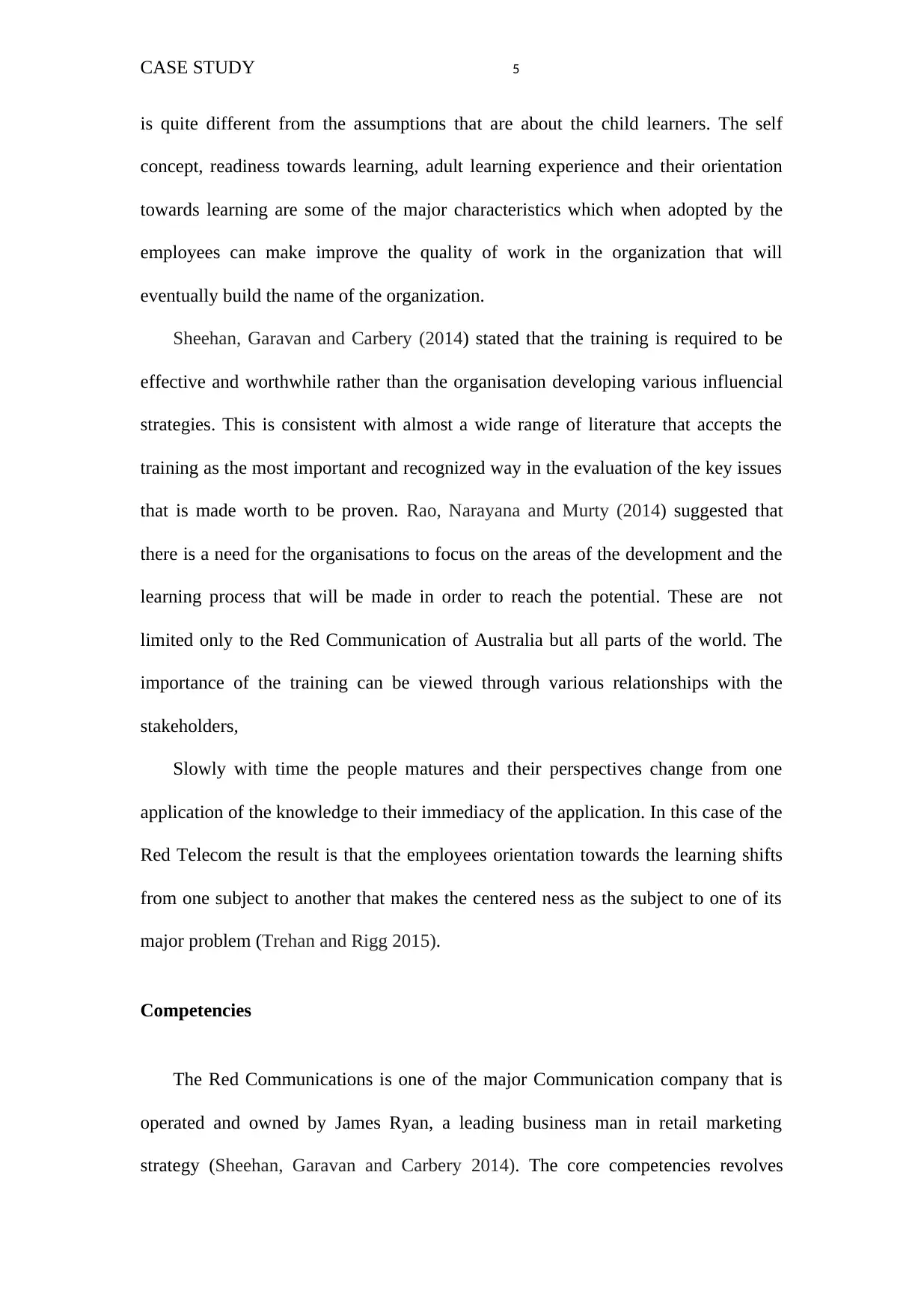
CASE STUDY 5
is quite different from the assumptions that are about the child learners. The self
concept, readiness towards learning, adult learning experience and their orientation
towards learning are some of the major characteristics which when adopted by the
employees can make improve the quality of work in the organization that will
eventually build the name of the organization.
Sheehan, Garavan and Carbery (2014) stated that the training is required to be
effective and worthwhile rather than the organisation developing various influencial
strategies. This is consistent with almost a wide range of literature that accepts the
training as the most important and recognized way in the evaluation of the key issues
that is made worth to be proven. Rao, Narayana and Murty (2014) suggested that
there is a need for the organisations to focus on the areas of the development and the
learning process that will be made in order to reach the potential. These are not
limited only to the Red Communication of Australia but all parts of the world. The
importance of the training can be viewed through various relationships with the
stakeholders,
Slowly with time the people matures and their perspectives change from one
application of the knowledge to their immediacy of the application. In this case of the
Red Telecom the result is that the employees orientation towards the learning shifts
from one subject to another that makes the centered ness as the subject to one of its
major problem (Trehan and Rigg 2015).
Competencies
The Red Communications is one of the major Communication company that is
operated and owned by James Ryan, a leading business man in retail marketing
strategy (Sheehan, Garavan and Carbery 2014). The core competencies revolves
is quite different from the assumptions that are about the child learners. The self
concept, readiness towards learning, adult learning experience and their orientation
towards learning are some of the major characteristics which when adopted by the
employees can make improve the quality of work in the organization that will
eventually build the name of the organization.
Sheehan, Garavan and Carbery (2014) stated that the training is required to be
effective and worthwhile rather than the organisation developing various influencial
strategies. This is consistent with almost a wide range of literature that accepts the
training as the most important and recognized way in the evaluation of the key issues
that is made worth to be proven. Rao, Narayana and Murty (2014) suggested that
there is a need for the organisations to focus on the areas of the development and the
learning process that will be made in order to reach the potential. These are not
limited only to the Red Communication of Australia but all parts of the world. The
importance of the training can be viewed through various relationships with the
stakeholders,
Slowly with time the people matures and their perspectives change from one
application of the knowledge to their immediacy of the application. In this case of the
Red Telecom the result is that the employees orientation towards the learning shifts
from one subject to another that makes the centered ness as the subject to one of its
major problem (Trehan and Rigg 2015).
Competencies
The Red Communications is one of the major Communication company that is
operated and owned by James Ryan, a leading business man in retail marketing
strategy (Sheehan, Garavan and Carbery 2014). The core competencies revolves
⊘ This is a preview!⊘
Do you want full access?
Subscribe today to unlock all pages.

Trusted by 1+ million students worldwide
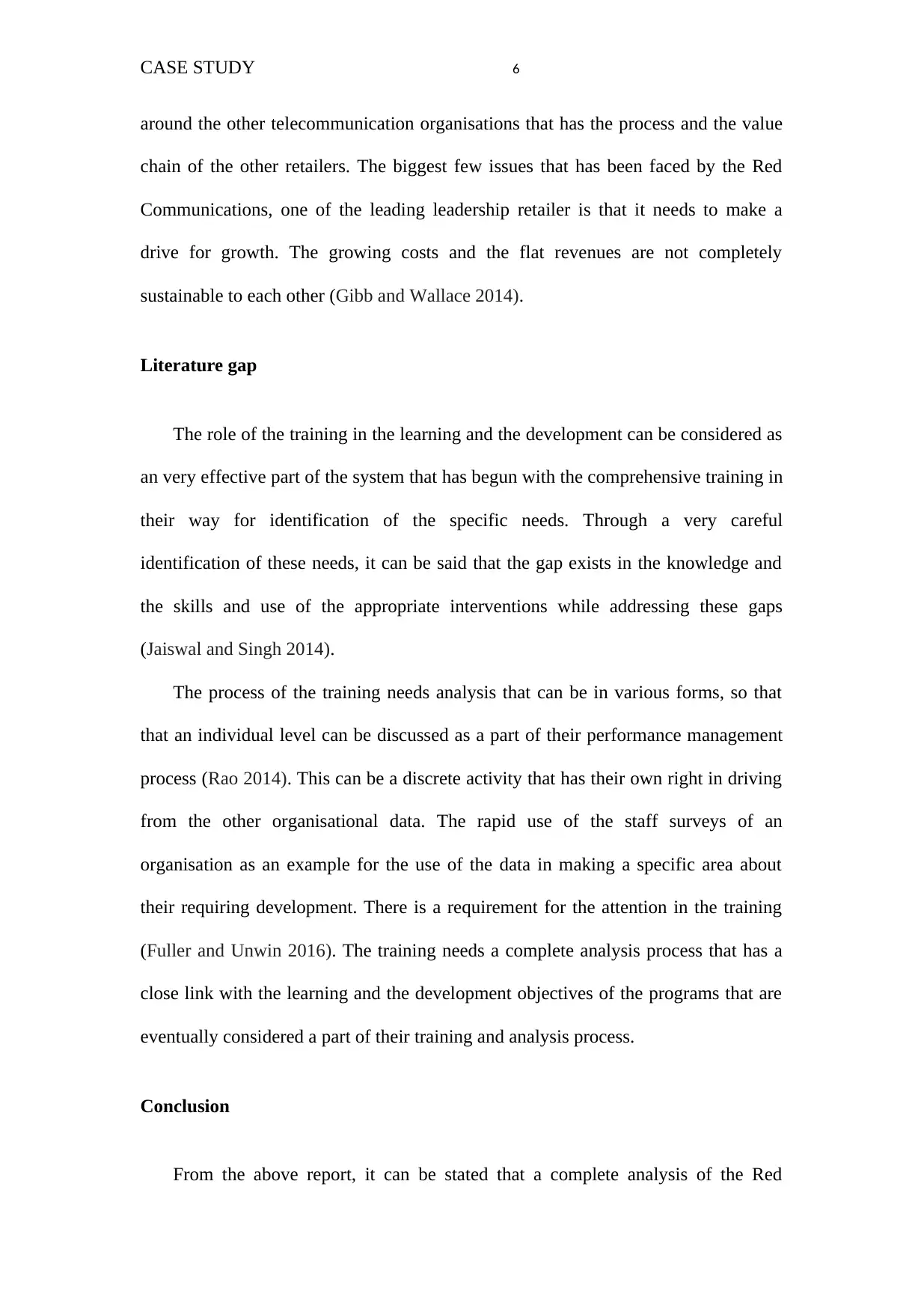
CASE STUDY 6
around the other telecommunication organisations that has the process and the value
chain of the other retailers. The biggest few issues that has been faced by the Red
Communications, one of the leading leadership retailer is that it needs to make a
drive for growth. The growing costs and the flat revenues are not completely
sustainable to each other (Gibb and Wallace 2014).
Literature gap
The role of the training in the learning and the development can be considered as
an very effective part of the system that has begun with the comprehensive training in
their way for identification of the specific needs. Through a very careful
identification of these needs, it can be said that the gap exists in the knowledge and
the skills and use of the appropriate interventions while addressing these gaps
(Jaiswal and Singh 2014).
The process of the training needs analysis that can be in various forms, so that
that an individual level can be discussed as a part of their performance management
process (Rao 2014). This can be a discrete activity that has their own right in driving
from the other organisational data. The rapid use of the staff surveys of an
organisation as an example for the use of the data in making a specific area about
their requiring development. There is a requirement for the attention in the training
(Fuller and Unwin 2016). The training needs a complete analysis process that has a
close link with the learning and the development objectives of the programs that are
eventually considered a part of their training and analysis process.
Conclusion
From the above report, it can be stated that a complete analysis of the Red
around the other telecommunication organisations that has the process and the value
chain of the other retailers. The biggest few issues that has been faced by the Red
Communications, one of the leading leadership retailer is that it needs to make a
drive for growth. The growing costs and the flat revenues are not completely
sustainable to each other (Gibb and Wallace 2014).
Literature gap
The role of the training in the learning and the development can be considered as
an very effective part of the system that has begun with the comprehensive training in
their way for identification of the specific needs. Through a very careful
identification of these needs, it can be said that the gap exists in the knowledge and
the skills and use of the appropriate interventions while addressing these gaps
(Jaiswal and Singh 2014).
The process of the training needs analysis that can be in various forms, so that
that an individual level can be discussed as a part of their performance management
process (Rao 2014). This can be a discrete activity that has their own right in driving
from the other organisational data. The rapid use of the staff surveys of an
organisation as an example for the use of the data in making a specific area about
their requiring development. There is a requirement for the attention in the training
(Fuller and Unwin 2016). The training needs a complete analysis process that has a
close link with the learning and the development objectives of the programs that are
eventually considered a part of their training and analysis process.
Conclusion
From the above report, it can be stated that a complete analysis of the Red
Paraphrase This Document
Need a fresh take? Get an instant paraphrase of this document with our AI Paraphraser
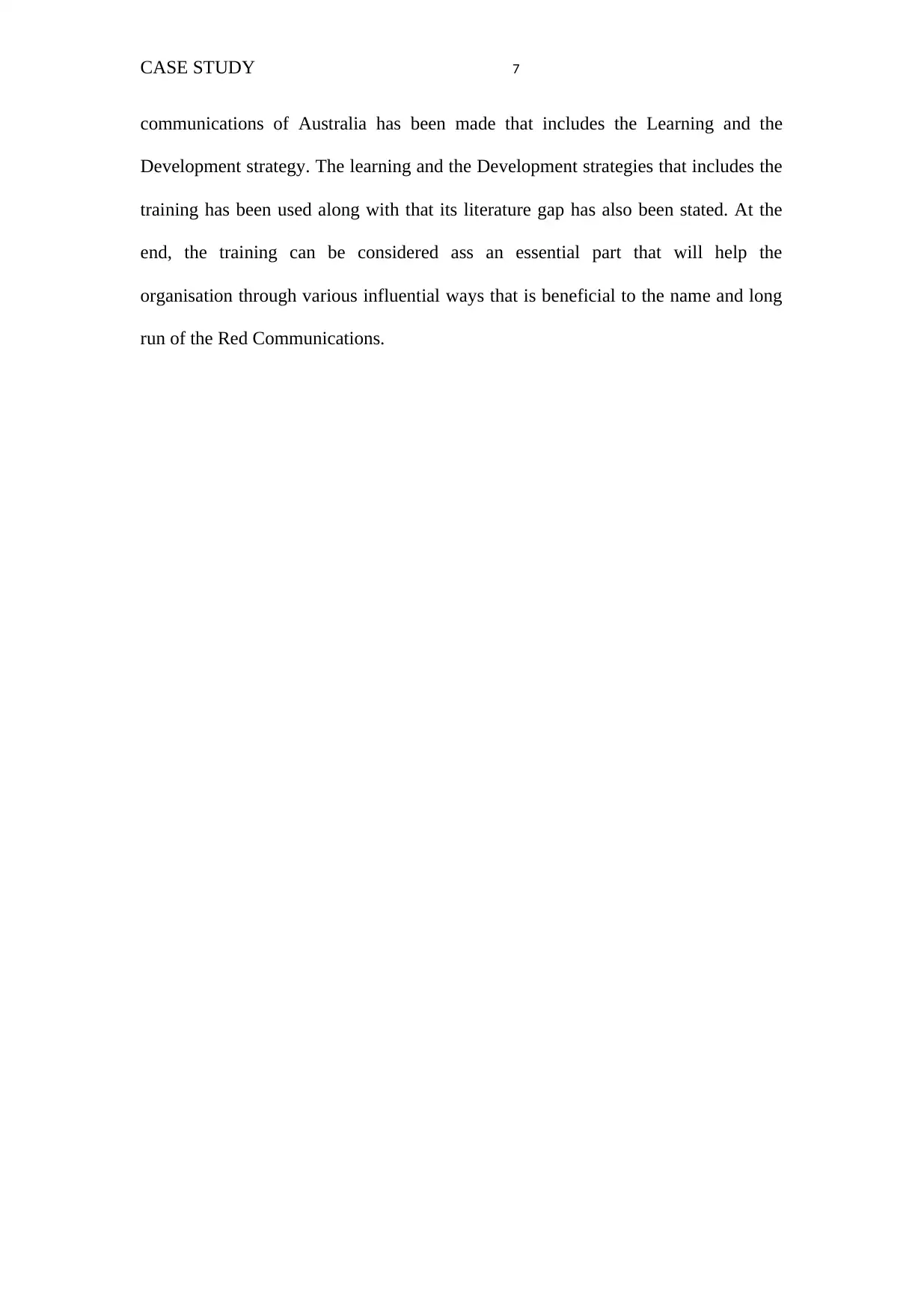
CASE STUDY 7
communications of Australia has been made that includes the Learning and the
Development strategy. The learning and the Development strategies that includes the
training has been used along with that its literature gap has also been stated. At the
end, the training can be considered ass an essential part that will help the
organisation through various influential ways that is beneficial to the name and long
run of the Red Communications.
communications of Australia has been made that includes the Learning and the
Development strategy. The learning and the Development strategies that includes the
training has been used along with that its literature gap has also been stated. At the
end, the training can be considered ass an essential part that will help the
organisation through various influential ways that is beneficial to the name and long
run of the Red Communications.
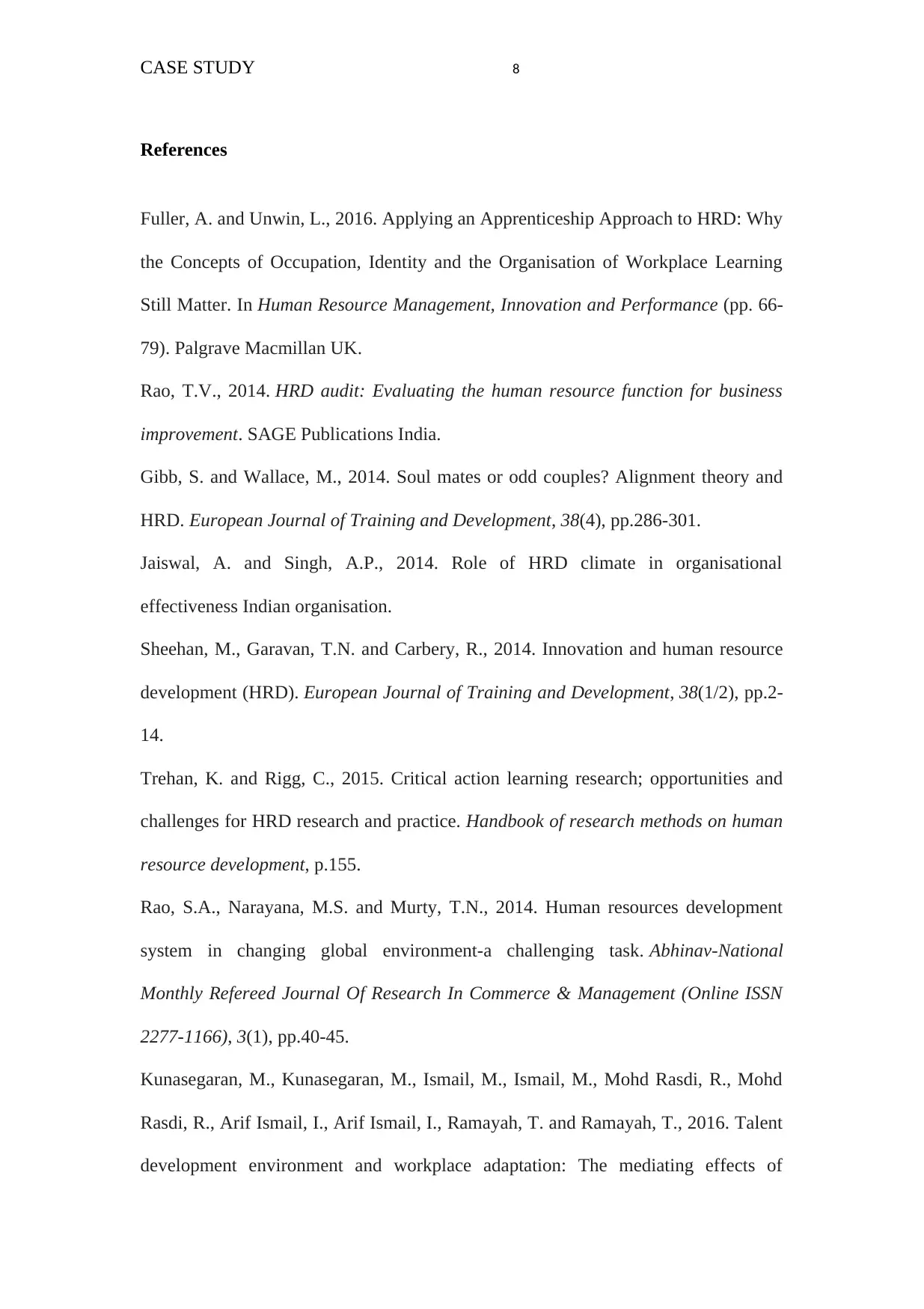
CASE STUDY 8
References
Fuller, A. and Unwin, L., 2016. Applying an Apprenticeship Approach to HRD: Why
the Concepts of Occupation, Identity and the Organisation of Workplace Learning
Still Matter. In Human Resource Management, Innovation and Performance (pp. 66-
79). Palgrave Macmillan UK.
Rao, T.V., 2014. HRD audit: Evaluating the human resource function for business
improvement. SAGE Publications India.
Gibb, S. and Wallace, M., 2014. Soul mates or odd couples? Alignment theory and
HRD. European Journal of Training and Development, 38(4), pp.286-301.
Jaiswal, A. and Singh, A.P., 2014. Role of HRD climate in organisational
effectiveness Indian organisation.
Sheehan, M., Garavan, T.N. and Carbery, R., 2014. Innovation and human resource
development (HRD). European Journal of Training and Development, 38(1/2), pp.2-
14.
Trehan, K. and Rigg, C., 2015. Critical action learning research; opportunities and
challenges for HRD research and practice. Handbook of research methods on human
resource development, p.155.
Rao, S.A., Narayana, M.S. and Murty, T.N., 2014. Human resources development
system in changing global environment-a challenging task. Abhinav-National
Monthly Refereed Journal Of Research In Commerce & Management (Online ISSN
2277-1166), 3(1), pp.40-45.
Kunasegaran, M., Kunasegaran, M., Ismail, M., Ismail, M., Mohd Rasdi, R., Mohd
Rasdi, R., Arif Ismail, I., Arif Ismail, I., Ramayah, T. and Ramayah, T., 2016. Talent
development environment and workplace adaptation: The mediating effects of
References
Fuller, A. and Unwin, L., 2016. Applying an Apprenticeship Approach to HRD: Why
the Concepts of Occupation, Identity and the Organisation of Workplace Learning
Still Matter. In Human Resource Management, Innovation and Performance (pp. 66-
79). Palgrave Macmillan UK.
Rao, T.V., 2014. HRD audit: Evaluating the human resource function for business
improvement. SAGE Publications India.
Gibb, S. and Wallace, M., 2014. Soul mates or odd couples? Alignment theory and
HRD. European Journal of Training and Development, 38(4), pp.286-301.
Jaiswal, A. and Singh, A.P., 2014. Role of HRD climate in organisational
effectiveness Indian organisation.
Sheehan, M., Garavan, T.N. and Carbery, R., 2014. Innovation and human resource
development (HRD). European Journal of Training and Development, 38(1/2), pp.2-
14.
Trehan, K. and Rigg, C., 2015. Critical action learning research; opportunities and
challenges for HRD research and practice. Handbook of research methods on human
resource development, p.155.
Rao, S.A., Narayana, M.S. and Murty, T.N., 2014. Human resources development
system in changing global environment-a challenging task. Abhinav-National
Monthly Refereed Journal Of Research In Commerce & Management (Online ISSN
2277-1166), 3(1), pp.40-45.
Kunasegaran, M., Kunasegaran, M., Ismail, M., Ismail, M., Mohd Rasdi, R., Mohd
Rasdi, R., Arif Ismail, I., Arif Ismail, I., Ramayah, T. and Ramayah, T., 2016. Talent
development environment and workplace adaptation: The mediating effects of
⊘ This is a preview!⊘
Do you want full access?
Subscribe today to unlock all pages.

Trusted by 1+ million students worldwide
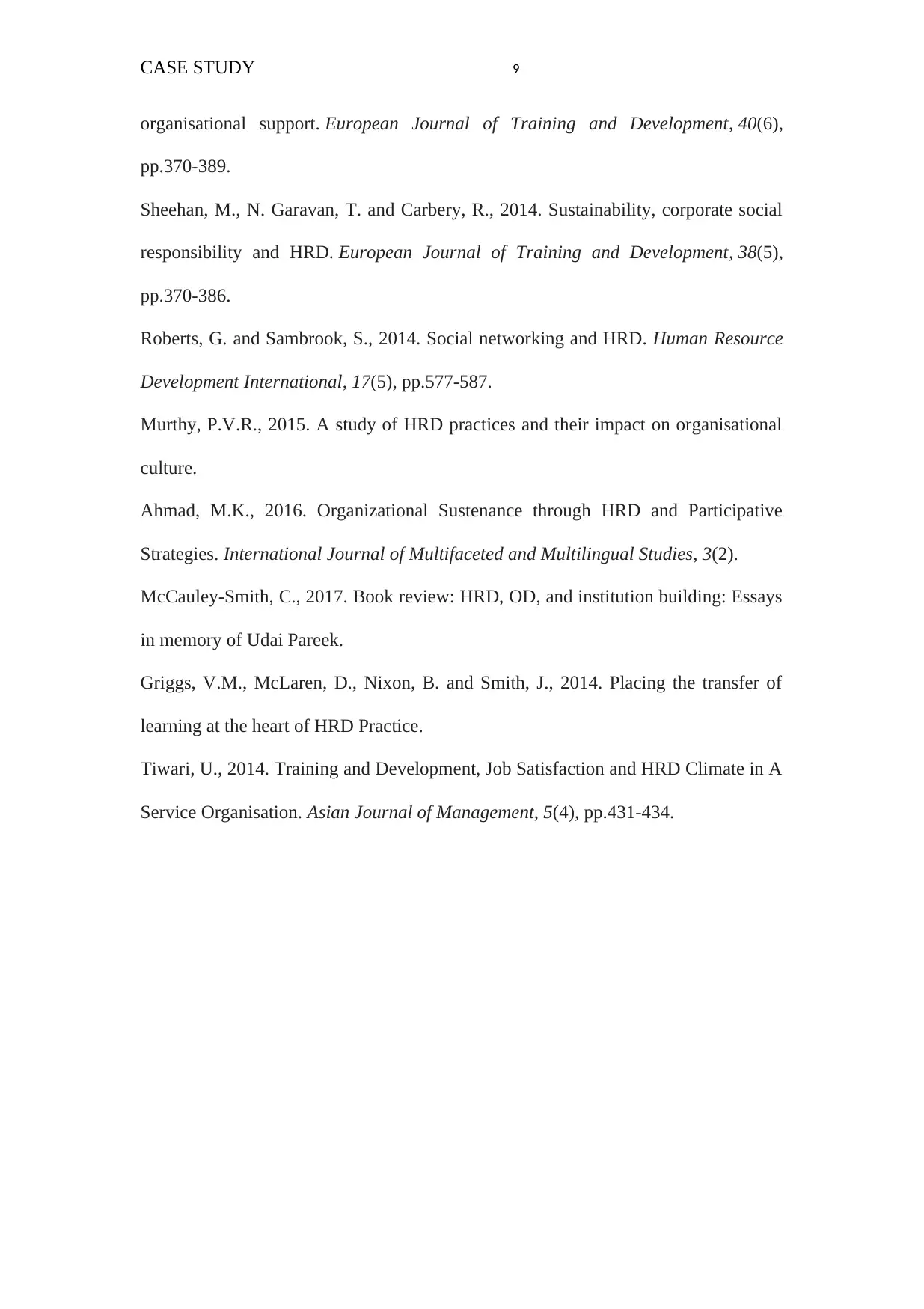
CASE STUDY 9
organisational support. European Journal of Training and Development, 40(6),
pp.370-389.
Sheehan, M., N. Garavan, T. and Carbery, R., 2014. Sustainability, corporate social
responsibility and HRD. European Journal of Training and Development, 38(5),
pp.370-386.
Roberts, G. and Sambrook, S., 2014. Social networking and HRD. Human Resource
Development International, 17(5), pp.577-587.
Murthy, P.V.R., 2015. A study of HRD practices and their impact on organisational
culture.
Ahmad, M.K., 2016. Organizational Sustenance through HRD and Participative
Strategies. International Journal of Multifaceted and Multilingual Studies, 3(2).
McCauley-Smith, C., 2017. Book review: HRD, OD, and institution building: Essays
in memory of Udai Pareek.
Griggs, V.M., McLaren, D., Nixon, B. and Smith, J., 2014. Placing the transfer of
learning at the heart of HRD Practice.
Tiwari, U., 2014. Training and Development, Job Satisfaction and HRD Climate in A
Service Organisation. Asian Journal of Management, 5(4), pp.431-434.
organisational support. European Journal of Training and Development, 40(6),
pp.370-389.
Sheehan, M., N. Garavan, T. and Carbery, R., 2014. Sustainability, corporate social
responsibility and HRD. European Journal of Training and Development, 38(5),
pp.370-386.
Roberts, G. and Sambrook, S., 2014. Social networking and HRD. Human Resource
Development International, 17(5), pp.577-587.
Murthy, P.V.R., 2015. A study of HRD practices and their impact on organisational
culture.
Ahmad, M.K., 2016. Organizational Sustenance through HRD and Participative
Strategies. International Journal of Multifaceted and Multilingual Studies, 3(2).
McCauley-Smith, C., 2017. Book review: HRD, OD, and institution building: Essays
in memory of Udai Pareek.
Griggs, V.M., McLaren, D., Nixon, B. and Smith, J., 2014. Placing the transfer of
learning at the heart of HRD Practice.
Tiwari, U., 2014. Training and Development, Job Satisfaction and HRD Climate in A
Service Organisation. Asian Journal of Management, 5(4), pp.431-434.
1 out of 10
Related Documents
Your All-in-One AI-Powered Toolkit for Academic Success.
+13062052269
info@desklib.com
Available 24*7 on WhatsApp / Email
![[object Object]](/_next/static/media/star-bottom.7253800d.svg)
Unlock your academic potential
Copyright © 2020–2025 A2Z Services. All Rights Reserved. Developed and managed by ZUCOL.





